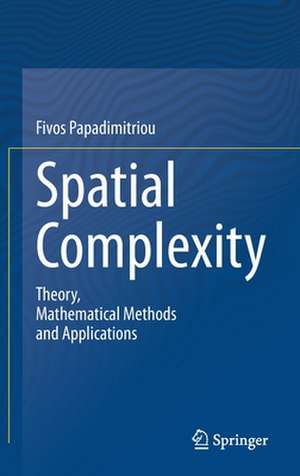Spatial Complexity: Theory, Mathematical Methods and Applications
Autor Fivos Papadimitriouen Limba Engleză Hardback – 3 noi 2020
How can one decide whether one surface or spatial object is more complex than another?
What does it require to measure the spatial complexity of small maps, and why does this matter for nature, science and technology?
Drawing from algorithmics, geometry, topology, probability and informatics, and with examples from everyday life, the reader is invited to cross the borders into the bewildering realm of spatial complexity, as it emerges from the study of geographic maps, landscapes, surfaces, knots, 3D and 4D objects.
The mathematical and cartographic experiments described in this book lead to hypotheses and enigmas with ramifications in aesthetics and epistemology.
| Toate formatele și edițiile | Preț | Express |
|---|---|---|
| Paperback (1) | 782.42 lei 6-8 săpt. | |
| Springer International Publishing – 3 noi 2021 | 782.42 lei 6-8 săpt. | |
| Hardback (1) | 788.41 lei 6-8 săpt. | |
| Springer International Publishing – 3 noi 2020 | 788.41 lei 6-8 săpt. |
Preț: 788.41 lei
Preț vechi: 961.47 lei
-18% Nou
Puncte Express: 1183
Preț estimativ în valută:
150.86€ • 157.93$ • 124.83£
150.86€ • 157.93$ • 124.83£
Carte tipărită la comandă
Livrare economică 05-19 aprilie
Preluare comenzi: 021 569.72.76
Specificații
ISBN-13: 9783030596705
ISBN-10: 3030596702
Pagini: 298
Ilustrații: XXI, 298 p. 178 illus., 149 illus. in color.
Dimensiuni: 155 x 235 mm
Greutate: 0.63 kg
Ediția:1st ed. 2020
Editura: Springer International Publishing
Colecția Springer
Locul publicării:Cham, Switzerland
ISBN-10: 3030596702
Pagini: 298
Ilustrații: XXI, 298 p. 178 illus., 149 illus. in color.
Dimensiuni: 155 x 235 mm
Greutate: 0.63 kg
Ediția:1st ed. 2020
Editura: Springer International Publishing
Colecția Springer
Locul publicării:Cham, Switzerland
Cuprins
What is Spatial Complexity?.- Spatial Complexity in Nature.- Scientific and Technological Applications of Spatial Complexity.- Geometry and Spatial Complexity.- Probabilities and Spatial Complexity.- Algorithms and Spatial.- Complexity.- Topology and Spatial Complexity.- Creating Spatial Complexity from simple Maps.- Spatial Entropy and Spatial Complexity.- Spatial Information and Spatial Complexity.- Enigmas of Spatial Complexity.- Spatial Complexity on 3-Dimensional Surfaces.- Spatial Complexity in 4-Dimensional Spaces.- Spatial Complexity and Aesthetics.- Spatial Complexity and Psychology.- Philosophical Perspectives on Spatial Complexity.- Future Research in Spatial Complexity.
Recenzii
“With this book, Dr Papadimitriou shows that the examination of spatial complexity is a problem on its own, and that, although the basic theory for its assessment should (expectedly) be mathematical, its connections with non-mathematical concepts and ideas leads us to a trove of applications for geography never imagined before.” (John Lidstone, IRGEE International Research in Geography and Environmental Education, August 20, 2021)
Notă biografică
Dr.Dr. Fivos Papadimitriou, B.Sc. (Athens), M.Sc. (Athens), M.Sc. (Paris), M.Ed. (Patras), Ph.D. (Budapest), Ph.D. (Oxford), is at the University of Tübingen. He has created new mathematical formulas, models and methods for measuring landscape complexity and spatial complexity.
Textul de pe ultima copertă
This book delivers stimulating input for a broad range of researchers, from geographers and ecologists to psychologists interested in spatial perception and physicists researching in complex systems.
How can one decide whether one surface or spatial object is more complex than another?
What does it require to measure the spatial complexity of small maps, and why does this matter for nature, science and technology?
How can one decide whether one surface or spatial object is more complex than another?
What does it require to measure the spatial complexity of small maps, and why does this matter for nature, science and technology?
Drawing from algorithmics, geometry, topology, probability and informatics, and with examples from everyday life, the reader is invited to cross the borders into the bewildering realm of spatial complexity, as it emerges from the study of geographic maps, landscapes, surfaces, knots, 3D and 4D objects.
The mathematical and cartographic experiments described in this book lead to hypotheses and enigmas with ramifications in aesthetics and epistemology.
Caracteristici
Presents an accessible mathematical foundation of Spatial Complexity Provides simple methods for assessing the Spatial Complexity of small maps Examines Spatial Complexity in an interdisciplinary manner, with applications in natural sciences, technology, and humanities
